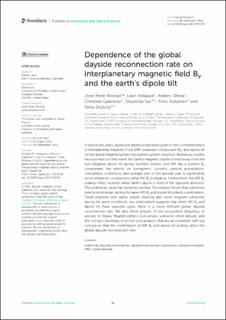| dc.contributor.author | Reistad, Jone Peter | |
| dc.contributor.author | Holappa, Lauri | |
| dc.contributor.author | Ohma, Anders | |
| dc.contributor.author | Gabrielse, Christine | |
| dc.contributor.author | Sur, Dibyendu | |
| dc.contributor.author | Asikainen, Timo | |
| dc.contributor.author | DeJong, Anna | |
| dc.date.accessioned | 2023-03-20T11:54:07Z | |
| dc.date.available | 2023-03-20T11:54:07Z | |
| dc.date.created | 2022-11-16T12:11:31Z | |
| dc.date.issued | 2022 | |
| dc.identifier.issn | 2296-987X | |
| dc.identifier.uri | https://hdl.handle.net/11250/3059230 | |
| dc.description.abstract | In the recent years, significant attention has been given to the combined effect of Interplanetary Magnetic Field (IMF) duskward component (By) and dipole tilt on the global magnetosphere-ionosphere system response. Numerous studies have pointed out that when the Earth’s magnetic dipole is tilted away from the Sun (negative dipole tilt during northern winter), and IMF has a positive By component, the effects on ionospheric currents, particle precipitation, ionospheric convection, and average size of the auroral oval, is significantly more enhanced, compared to when IMF By is negative. Furthermore, this IMF By polarity effect reverses when Earth’s dipole is tilted in the opposite direction. The underlying cause has remained unclear. Our analysis shows that substorms tend to be stronger during the same IMF By and dipole tilt polarity combination. Taken together with earlier results showing also more frequent substorms during the same conditions, our observations suggests that when IMF By and dipole tilt have opposite signs, there is a more efficient global dayside reconnection rate. We also show analysis of the occurrence frequency of periods of Steady Magnetospheric Convection, substorm onset latitude, and the isotropic boundary of proton precipitation, that are all consistent with our conclusion that the combination of IMF By and dipole tilt polarity affect the global dayside reconnection rate. | en_US |
| dc.language.iso | eng | en_US |
| dc.publisher | Frontiers | en_US |
| dc.rights | Navngivelse 4.0 Internasjonal | * |
| dc.rights.uri | http://creativecommons.org/licenses/by/4.0/deed.no | * |
| dc.title | Dependence of the global dayside reconnection rate on interplanetary magnetic field By and the earth’s dipole tilt | en_US |
| dc.type | Journal article | en_US |
| dc.type | Peer reviewed | en_US |
| dc.description.version | publishedVersion | en_US |
| dc.rights.holder | Copyright 2022 The Author(s) | en_US |
| dc.source.articlenumber | 973276 | en_US |
| cristin.ispublished | true | |
| cristin.fulltext | original | |
| cristin.qualitycode | 1 | |
| dc.identifier.doi | 10.3389/fspas.2022.973276 | |
| dc.identifier.cristin | 2074781 | |
| dc.source.journal | Frontiers in Astronomy and Space Sciences | en_US |
| dc.relation.project | Norges forskningsråd: 300844 | en_US |
| dc.identifier.citation | Frontiers in Astronomy and Space Sciences. 2022, 9, 973276. | en_US |
| dc.source.volume | 9 | en_US |

